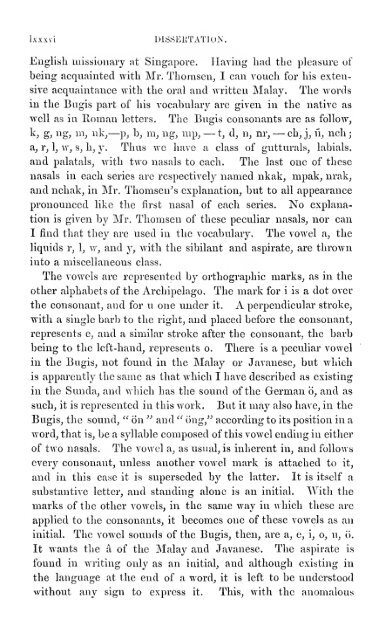A grammar and dictionary of the Malay language : with a preliminary ...
A grammar and dictionary of the Malay language : with a preliminary ...
A grammar and dictionary of the Malay language : with a preliminary ...
Create successful ePaper yourself
Turn your PDF publications into a flip-book with our unique Google optimized e-Paper software.
Ixxxvi DISSERTATION,<br />
English missionary at Singapore. Having had <strong>the</strong> pleasm-e <strong>of</strong><br />
being acquainted <strong>with</strong> Mr. Thomsen, I can vouch for his exten-<br />
sive acquaintance <strong>with</strong> <strong>the</strong> oral <strong>and</strong> written <strong>Malay</strong>. The words<br />
in <strong>the</strong> Bugis part <strong>of</strong> his vocabulary are given in <strong>the</strong> native as<br />
well as in Roman letters. The Bugis consonants are as follow,<br />
kj g, ng, m, nk,— p, b, m, ng, mp, — t, d, n, nr, — ch, j, ii, nch<br />
a, r, \, ^y, s, h, y. Thus we have a class <strong>of</strong> gutturals, labials,<br />
<strong>and</strong> palatals, <strong>with</strong> two nasals to each. The last one <strong>of</strong> <strong>the</strong>se<br />
nasals in each series are respectively named nkak, mpak, nrak,<br />
<strong>and</strong> nchak, in Mr. Thomsen's explanation, but to all appearance<br />
pronounced like <strong>the</strong> first nasal <strong>of</strong> each series. No explana-<br />
tion is given by Mr. Thomsen <strong>of</strong> <strong>the</strong>se peculiar nasals, nor can<br />
I find that <strong>the</strong>y are used in <strong>the</strong> vocabulary. The vowel a, <strong>the</strong><br />
liquids r, 1, w, <strong>and</strong> y, <strong>with</strong> <strong>the</strong> sibilant <strong>and</strong> aspirate, are thrown<br />
into a miscellaneous class.<br />
The vowels are represented by orthographic marks, as in <strong>the</strong><br />
o<strong>the</strong>r alphabets <strong>of</strong> <strong>the</strong> Archipelago. The mark for i is a dot over<br />
<strong>the</strong> consonant, <strong>and</strong> for u one under it. A perpendicular stroke,<br />
<strong>with</strong> a single barb to <strong>the</strong> right, <strong>and</strong> placed before <strong>the</strong> consonant,<br />
represents e, <strong>and</strong> a similar stroke after <strong>the</strong> consonant, <strong>the</strong> barb<br />
being to <strong>the</strong> left-h<strong>and</strong>, represents o. There is a peculiar vowel<br />
in <strong>the</strong> Bugis, not found in <strong>the</strong> <strong>Malay</strong> or Javanese, but which<br />
is apparently <strong>the</strong> same as that which I have described as existing<br />
in <strong>the</strong> Sunda, <strong>and</strong> which has <strong>the</strong> sound <strong>of</strong> <strong>the</strong> German o, <strong>and</strong> as<br />
such, it is represented in this work. But it may also have, in <strong>the</strong><br />
Bugis, <strong>the</strong> sound, " on " <strong>and</strong> " ong,'' according to its position in a<br />
word, that is, be a syllable composed <strong>of</strong> this vowel ending in ei<strong>the</strong>r<br />
<strong>of</strong> two nasals. The vowel a, as usual, is inherent in, <strong>and</strong> follows<br />
every consonant, unless ano<strong>the</strong>r vowel mark is attached to it,<br />
<strong>and</strong> in this case it is superseded by <strong>the</strong> latter. It is itself a<br />
substantive letter, <strong>and</strong> st<strong>and</strong>ing alone is an initial. Witli <strong>the</strong><br />
marks <strong>of</strong> <strong>the</strong> o<strong>the</strong>r vowels, in <strong>the</strong> same way in which <strong>the</strong>se are<br />
applied to <strong>the</strong> consonants, it becomes one <strong>of</strong> <strong>the</strong>se vowels as an<br />
initial. The vowel sounds <strong>of</strong> <strong>the</strong> Bugis, <strong>the</strong>n, are a, e, i, o, u, o.<br />
It wants <strong>the</strong> a <strong>of</strong> <strong>the</strong> <strong>Malay</strong> <strong>and</strong> Javanese. The aspirate is<br />
found in w'riting only as an initial, <strong>and</strong> although existing in<br />
<strong>the</strong> <strong>language</strong> at <strong>the</strong> end <strong>of</strong> a word, it is left to be understood<br />
<strong>with</strong>out any sign to express it. This, <strong>with</strong> <strong>the</strong> anomalous<br />
;

















